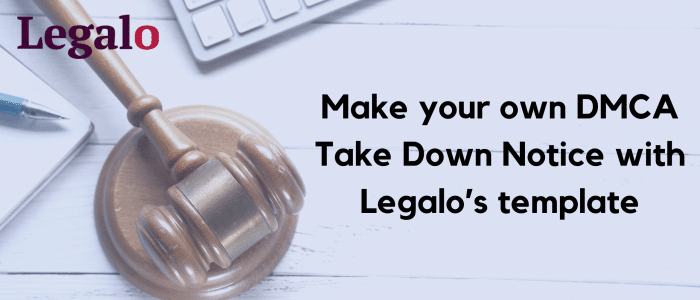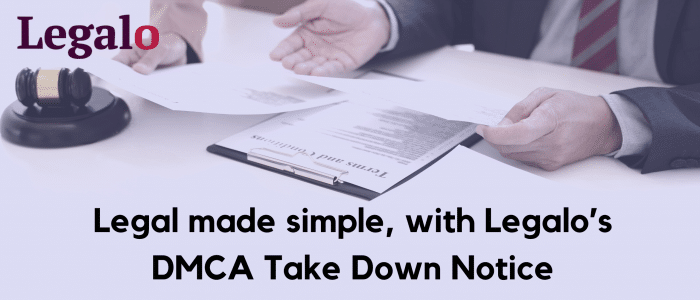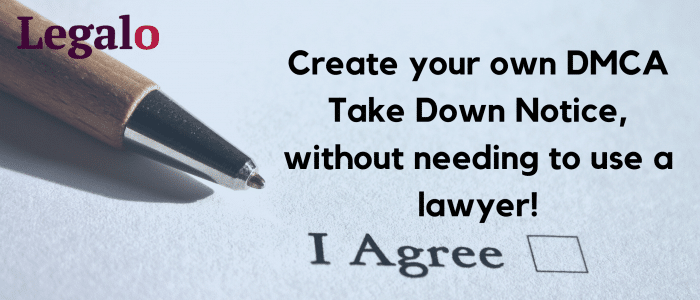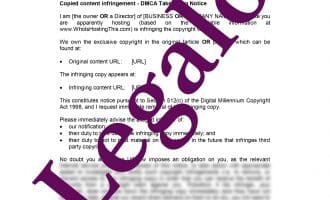DMCA Take Down Notice
Our DMCA Take Down Notice template:
- Use it to get the infringer’s host to remove the infringing material
- Complete it in just a few minutes
- Expertly drafted in the UK
- Money-back guarantee

How Does It Work?
-
1. Download
-
2. Edit
-
3. Print
-
4. Sign
Our DMCA Take Down Notice template is for use by any website whose copyright content has been breached by its being copied by someone without permission.
The notice takes the form of a letter, which we have kept straightforward, while still complying with the various requirements under the DMCA (the Digital Millennium Copyright Act 1998 in USA) for it to be a DMCA Take Down Notice.
The steps in DMCA copyright cases
STEP 1: This notice is for use after you have first written to the infringer to demand that they remove the offending material, but unfortunately, despite this demand, they have not done so promptly. So step 1 is to write to the infringer. (In case you need one, here is a link to our Copied Content Complaint Letter, which you can use first.)
STEP 2: The next step, if you need it, is to tackle their ISP with a DMCA Take Down Notice. Technically, this is part of US law, not UK law, as the DMCA is a North American statute. However, given that many ISPs are North American or have branches there and all ISPs should be familiar with the DMCA take down procedure even if not based in North America, you will probably find that trying this procedure works for you. In any event, it is worth trying before resorting to the UK courts, since the court system here is incredibly slow, as well as more expensive than this DMCA process.
STEP 3: If their ISP does not comply, then you can re-use this template to send a similar letter to all of the major search engines to see if you can resolve the problem that way instead.
STEP 4: Hopefully, you won’t need to go this far, but the next step, if all others have failed, is to take the infringer to court.
Using our DMCA Take Down Notice template
It will truly only take you a few minutes to complete the template and produce your DMCA take down notice. You can then send it off, wait a few days to see if it achieves the result and then check the offending website again to see if the infringing material has now been taken down or blocked. With the guide that comes with the template, it could not be easier.
If you first need to send out a copied content complaint letter (this really is advisable if you have not done so already), then please see our template for this.

Filing a DMCA Take Down Notice
You can file your DMCA take down notice as follows:
1. Consider if the web-page infringes yours – take advice from a law firm if in doubt.
2. Print off or save screenshots of the infringing website in case of changes being made to it or it is taken down or modified, but a dispute still develops.
3. Use www.whoishostingthis.com or the like, in order to find out which ISP is hosting the infringing website.
4. Go to the hosting company’s website in order to find out their contact details (e.g. their DMCA agent).
5. If that is unsuccessful, you can check if the hosting company has registered as host with the U.S. Copyright Office – they may have registered their contact details there.
6. Fill in the DMCA take down notice template (see the details below) and send it off to the hosting ISP.
7. Give them at least 3 days if sent by email or fax (longer if sent only by post) and then check to see if they have taken down the infringing web-page or at least the infringing content has been removed.
8. If this is unsuccessful, file a similar DMCA take down notice with all of the major search engines; give them a few days and then check the offending website again.
If this process works, which it generally does, it provides a quick and simple solution for you. The main thing is to give them a bit of time to react – some are quicker than others – and then double-check to see if they have removed the web-page.
Clauses in the Template
The following is an abbreviated version of the guide that accompanies the template when bought:
The idea is that you will print this letter on your letterhead notepaper (or the equivalent with all your business’s usual details). Therefore delete the heading that refers to it being on your letterhead notepaper.
Address it to the infringer’s host ISP by inserting the name and address of the hosting ISP where indicated.
Fill in the date, i.e. the actual date you sign it. You can write this in by hand once you have signed the letter, or you can type it in.
In the first paragraph, select whether you are owner of the business or a director of the company in question.
In the second paragraph, select which option applies to your infringed material – whether it is an article or a picture.
After the second paragraph, where it says “Original content URL:”, at the end fill in the URL of your infringed Web-page. Where it says “Infringing content URL:”, at the end fill in the URL of the infringing Web-page.
We have designed the rest of the letter to comply with the DMCA requirements for a take down notice. This particularly concerns the penultimate paragraph, which you should not alter.

FAQs on the DMCA Take Down Notice
Below, we have answered the most popular queries on the Internet about DMCA Take Down Notices.
Does DMCA work in the UK?
Technically DMCA is part of US law, not UK law, as the DMCA is a North American statute. However, given that (a) many ISPs are North American or have branches there, and (b) all ISPs should be familiar with the DMCA take down procedure even if not based in North America, you will probably find that trying this procedure works for you.
Does DMCA only apply to the USA?
As noted above, while DMCA is a US specific law, often you can use it in worldwide disputes, as many ISPs are, or have branches, in North America. It is also the most widely-recognised copyright infringement notice and is therefore often taken notice of in countries other than the US.
The UK does have an alternative notice called the CDPA (Copyright, Designs and Patents Act 1988) which has similar attributes and serves a similar purpose in protecting the copyright holders’ rights, but does require that you go to court to enforce your rights, and therefore:
- takes much longer to complete; and
- is a lot more complex and expensive.
In the UK, should I use DMCA or CDPA?
In the UK, when dealing with digital copyright infringements, it is perfectly acceptable to use DMCA rather than CDPA, as your website or online content is probably also available to US users. This has a number of advantages such as:
- being internationally recognised; and
- much faster than using UK courts, which would be required under CDPA.
Using a DMCA notice, you can contact Google and other search engines to ask them to force the offender to take down any infringing content from their website.
What happens if you break copyright law in the UK?
If you break copyright law in the UK, you can face legal consequences by the copyright holder. This can include removal of the infringing material, financial damages, and potential fines. To avoid this, you can often purchase licences from copyright owners to use and sell items based on their copyrighted material, in return for which you would pay them a royalty.
Do I need a DMCA notice?
If you believe that someone is using your copyright material without permission, specifically digitally and online, you can consider sending a DMCA to the infringing party notifying them of their infringement and asking them to take down the offending material. It can also be a useful tool if you are actively protecting your copyrights in order to establish a record of your efforts to combat infringement.
Who can send a DMCA notice?
Only the copyright holder, or an agent authorised by the copyright holder, can send a DMCA notice. In the case of a licensee being given permission to manage certain aspects of a copyright, they can also submit a DMCA notice. Before doing so, it is vital to ensure that your claim is legitimate to the copyright, as false claims can have legal consequences in the future and put a black mark against your brand.
How long does a DMCA take down take?
The time it takes for a DMCA take down varies. Online platforms generally respond in any time between a few days and two weeks. It is usually simple for them to take down the offending material, but a full resolution can take longer if the infringer ignores the notice, as you may need to take legal action.
How many DMCA strikes can you get?
Most online platforms have a system in which they allow a user a limited number of DMCA strikes, after which a user may accrue penalties. For example, platforms such as YouTube and Etsy have a three-strike system. Under this system, after three valid DMCA take down notices, the online platform may remove or suspend an account indefinitely. Some platforms even record the offender’s IP address, to ensure they don’t make any new accounts and repeat the behaviour.
How do you write a DMCA takedown?
Writing a DMCA take down notice involves specific elements to ensure its clarity and effect. Typically you send it to an online service provider, such as a website owner or content creator, and you request the removal of copyright content to which you own the rights. There are various details to include in a DMCA take down notice (see below for a list). The easiest and quickest way to write one is using Legalo’s great template.
It is important to make sure that the DMCA take down notice is accurate and well-founded. If it is not, the submitter could have to deal with legal consequences.
What should be included in a DMCA takedown notice?
In a DMCA take down notice, you must include:
- your personal information;
- details of the infringing content;
- proof of ownership;
- statement of good faith belief and accuracy;
- the contact information of the infringer; and
- the request for removal.
Use Legalo’s template, to ensure you don’t leave anything important out.
How long does copyright last in the UK?
When understanding the length of protection by copyright, it is dependent on the type of media relevant to your claim. Copyright for artistic, literary and musical words typically lasts for the creator’s lifetime plus 70 years after their death. However, there are exceptions:
- The law protects sound recordings and performances for 70 years from creation;
- Films are covered from publication until 70 years after the last relevant contributor’s death;
- Protection for broadcasts is for 50 years from year of broadcast; and
- Typographical arrangements are copyrighted for 25 years after publication.
Other countries will set different periods for copyright protection.
How much do you have to change artwork to avoid copyright UK?
Making changes to artwork or other copyrighted material does not guarantee that you will avoid copyright infringement. It is not enough to slightly change art. You should be paying a royalty and getting the artist’s permission if you want to use their art as a starting point. You need to produce unique art yourself instead of starting with someone else’s art. If you start by reworking someone else’s art, it can still be obvious that it was derived from something that is protected by copyright. A new work should demonstrate independent originality above all else. You should also not use recognisable characters that are subject to copyright, such as cartoon characters, e.g. Mickey Mouse.


